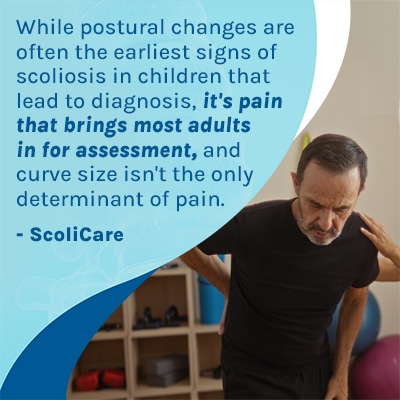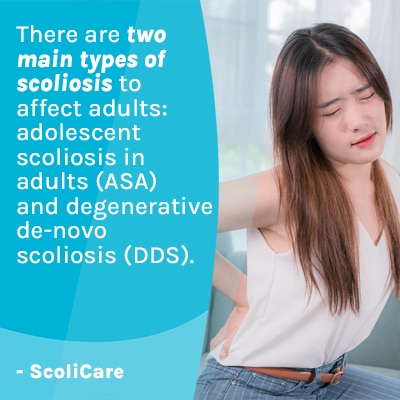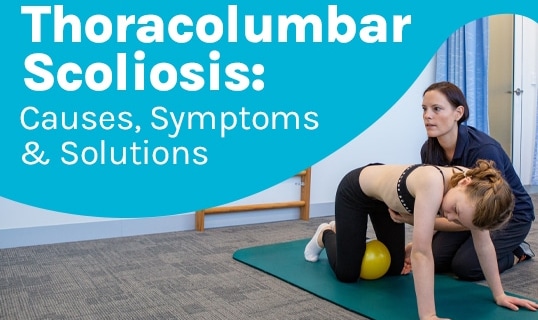Although scoliosis is most often diagnosed during adolescence, scoliosis can also develop later in life. Once skeletal maturity is reached, scoliosis changes in terms of progression and pain. A focus of scoliosis treatment for older adults is fall prevention.
Adult scoliosis can involve individuals who have had scoliosis since adolescence, or those who develop it with no prior history. Adolescent scoliosis in adults and degenerative de-novo scoliosis can be painful, progressive, and treatment focuses on restoring balance to the spine and body.
Before getting to the symptoms of adult scoliosis and treatment options, let’s discuss the two main types to affect adults, and how they differ.
Adult Scoliosis
Adult scoliosis is diagnosed in individuals who have reached skeletal maturity and have an unnatural lateral spinal curvature with rotation.
Scoliosis is most often diagnosed during childhood, so many consider it to be mainly a childhood condition, but the actual rate of scoliosis increases among the aging population; in adults over the age of 60, it’s estimated that 35.5 percent will be affected by scoliosis, and in patients between 60 and 90 years of age, estimates are as high as 68 percent (1).
 While postural changes are the earliest signs of scoliosis in children that lead to a diagnosis, it’s pain that brings most adults in for assessment, and curve size isn’t the only determinant of pain.
While postural changes are the earliest signs of scoliosis in children that lead to a diagnosis, it’s pain that brings most adults in for assessment, and curve size isn’t the only determinant of pain.
Scoliosis is progressive, and although we don’t know what causes the onset of most cases of scoliosis, we know growth causes progression.
There are two main types of scoliosis to affect adults: adolescent scoliosis in adults (ASA) and degenerative de-novo scoliosis (DDS) (2).
Adolescent Scoliosis In Adults
Scoliosis affects all ages, but the most common form is Adolescent Idiopathic Scoliosis diagnosed between the ages of 10 and 18, and while an unnatural spinal curve can sound noticeable, in mild cases, symptoms can be subtle (3).
As scoliosis progresses the spine and posture can collapse further, causing more compression, and compression may be one of the main causes of scoliosis pain (4).
Adults diagnosed with idiopathic scoliosis have usually had it since adolescence but were unaware, and these cases can be stable or progressive, and in cases where adults weren’t diagnosed during adolescence, it’s difficult to know how much progression has occurred because older X-ray images of the spine can’t be compared to current ones.
In cases of adolescent scoliosis in adults, it’s often back pain and radiating pain to the buttocks or legs that brings them in for assessment once skeletal maturity is reached and back pain occurs (3).
Degenerative De-Novo Scoliosis
Adult degenerative de-novo scoliosis develops fresh in adulthood with no prior history and affects middle-aged to older adults 45+ (1, 2, 4).
Degenerative scoliosis is caused by degenerative instability, and because it involves the spine becoming increasingly unbalanced and unstable, these adults are at risk of injury through a fall, and lower back pain is common (4, 5).
Cases of degenerative scoliosis are almost always progressive (5).
Most degenerative changes in the spine start with the intervertebral discs losing fluid as we age. The spine consists of vertebrae stacked on top of one another that are separated by an intervertebral disc, and if a disc degenerates and changes shape, it can disrupt the position of adjacent vertebrae attached, causing the spine to become misaligned and unbalanced.
Now that we’ve talked generally about the two main types of scoliosis to affect adults, let’s talk about the symptoms of adult scoliosis.
Symptoms of Adult Scoliosis
Symptoms of adult scoliosis are shaped by a number of factors, and while early detection is a focus of childhood scoliosis, adults can also benefit from early diagnosis and intervention (3, 6).
In order to recognize the need for assessment, the signs of scoliosis need to be recognized, and in adults, symptoms can include pain, postural changes, a noticeable lean to one side, and even forward, as the spine collapses, a loss of standing and/or sitting height, disruptions to movement and quality of life.
Additional clinical factors can include prior spinal surgery, having a family history of scoliosis, menopause, and/or conditions like osteoarthritis.
Spinal surgery changes the natural function of the spine and can make it more vulnerable to injury and/or the development of an unnatural spinal curve.
Degenerative scoliosis is more often diagnosed in females and seems to be correlated with changes in bone density and hormones caused by menopause, and osteoarthritis of the spine is a degenerative joint disease that erodes the spine’s protective cartilage (5).
So if a change is noticed in an adult’s posture that’s accompanied by pain and any of the aforementioned indicators, assessment is crucial.
As pain is the main symptom of adult scoliosis, let’s explore what makes adult scoliosis painful (3).
Adult Scoliosis Pain
The main symptom of adult scoliosis is lower back pain, and while scoliosis pain can range in severity, adult scoliosis pain can be severe, particularly in cases of degenerative scoliosis (3, 5).
There was a time when scoliosis wasn’t considered a painful condition due to the lack of pain in young patients, but we have learned that scoliosis affects adults differently, given how it evolves completely differently to adolescent scoliosis, and this understanding has led to better outcomes for adult scoliosis patients, particularly in the area of pain management and relief (3, 5).
When it comes to adult scoliosis pain, there are two main factors: curvature location and spinal balance (1, 6).
 Most people think it’s the size of the scoliosis that determines how painful it is, but this isn’t the case.
Most people think it’s the size of the scoliosis that determines how painful it is, but this isn’t the case.
Most back pain affecting adults involves the lower back, the lumbar spine, but pain can also develop in the thoracic spine and the cervical spine above (6).
In the majority of degenerative scoliosis cases, the spine’s unnatural bend and twist develops in the lower back, and in some cases of adolescent scoliosis in adults with an S-shaped curve, the curve’s bottom portion of the curve develops in the lower back, also causing lower back pain (4).
For a single curve in the thoracic spinal section, which is more common in adults living with adolescent scoliosis, lower back pain may not be as common.
So where in the spine the scoliosis develops is a key factor when it comes to back pain.
Balance of the spine is also important, and this is referring to the spine’s forward/backward and left/right shift in position (6).
Adults whose posture shifts forward or who are bent forward can experience more pain than patients whose posture remains neutral or shifts backwards (6).
A shift forward in posture means the upper body’s weight isn’t evenly distributed over the pelvis and lower body, causing uneven wear and tear on the joints of the lumbar spine, hips, and legs.
So what’s the answer? Can adult scoliosis treatment work towards improvement, or is it too late?
Adult Scoliosis Treatment Options
General treatment for adult scoliosis patients experiencing back pain include pain killers, anti-inflammatory medications, exercise and surgical treatment, but there are a lot more options available, and options capable of offering long-term pain relief.
Patients that are in pain are seeking relief. This may result in a quick medication prescription but doesn’t often address the cause of the pain. At ScoliCare, we assess the patient to be able to address the cause of the symptom: the underlying scoliosis.
So for any type of sustainable long-term pain relief, the scoliosis has to be impacted; pain medications offer a quick solution for short-term relief but don’t improve the actual cause of the pain.
The potential for significant curvature reductions in adults isn’t as possible as in young patients because an adult’s spine has stopped growing; an adult spine is more rigid and less responsive than growing spines.
In addition, many adults with scoliosis have experienced significant progression before reaching a diagnosis, and progression also increases spinal rigidity, but the good news is that scoliosis can be impacted in a number of ways to help correct adult scoliosis and reduce pain.
Because the majority of back pain is caused by the spine being off-balance, treatment that focuses on restoring the spine’s balance can result in a spine and body that’s more stable, and this also helps with fall prevention (7).
Exercise-Based Treatment
In some cases, the spine’s stability and back pain can be improved through an intensive and customized exercise-based treatment program: ScoliBalance® (8).
ScoliBalance® is individualized to each patient’s curve type, location, symptoms, and treatment goals.
Custom and corrective exercises focus on restoring the spine’s balance and body posture. Through postural awareness and restoration, it’s not just the spine that becomes more balanced, but the entire body (8, 9).
Through the use of scoliosis-specific exercises patients are taught how to be mindful of their spine and body’s position during daily activities, so ScoliBalance® can help reduce pain and slow/stop progression of the curve by reducing the uneven forces experienced by the spine and its surroundings.
In cases of degenerative scoliosis with degenerative progression occurring, a customized 3-dimensional corrective brace is often recommended (8).
Scoliosis Bracing
The ScoliBrace® is a custom 3D scoliosis brace that has the potential to support the spine, improve its stability, realign posture, reduce pain, and most importantly, improve quality of life (8).
In older adults with degenerative scoliosis, lower back pain and leg pain are the most common complaints (4).
While the spine’s natural design is movement-based, if there is too much movement within the spine, instability develops, and this is problematic; in these types of cases, bracing can be an effective means of improving the spine’s stability for pain relief (5, 6).
In younger adult patients, a major motivation is improving the body’s appearance, and bracing can also help address postural and cosmetic complaints.
If patients don’t respond to nonsurgical treatment, surgical procedures can be recommended; the sooner nonsurgical treatment is started, the more potential there is to impact adult scoliosis positively.
Conclusion
Adult scoliosis needs to be treated proactively, especially in older adults experiencing spinal degeneration.
The two main types of scoliosis to affect adults are adolescent scoliosis in adults and degenerative de-novo scoliosis, and in most cases of adolescent scoliosis in adults, the scoliosis is pre-existing from adolescence, while degenerative scoliosis develops with no prior history.
Although it’s growth that triggers progression, adult scoliosis still progresses, and when the spine starts to degenerate, scoliosis can progress faster as the spine becomes increasingly unbalanced and unstable.
Here at ScoliCare, nonsurgical treatment is innovative, integrative, and individualized, and combines the potential of ScoliBalance® and the ultra-corrective ScoliBrace®.
Through specialized scoliosis exercises and corrective bracing, the spine’s position may be significantly improved, and this change extends to the body’s overall symmetry and posture.
While there are no treatment guarantees, the sooner nonsurgical scoliosis treatment is started, the more potential it has to correct the curve, improve posture, the spine’s balance, stability, and reduce pain for long-term improvements to quality of life.
References:
- McAviney J, Roberts C, Sullivan B, Alevras AJ, Graham PL, Brown BT. The prevalence of adult de novo scoliosis: A systematic review and meta-analysis. Eur Spine J. 2020 Dec;29(12):2960-2969. doi: 10.1007/s00586-020-06453-0. Epub 2020 May 22. PMID: 32440771
- Aebi, M. (2005). The adult scoliosis. European spine journal, 14(10), 925-948.
- Negrini, S., Donzelli, S., Aulisa, A. G., Czaprowski, D., Schreiber, S., de Mauroy, J. C., … & Zaina, F. (2018). 2016 SOSORT guidelines: orthopaedic and rehabilitation treatment of idiopathic scoliosis during growth. Scoliosis and spinal disorders, 13(1), 3.
- Zaina, F., Marchese, R., Donzelli, S., Cordani, C., Pulici, C., McAviney, J., & Negrini, S. (2023). Current knowledge on the different characteristics of back pain in adults with and without scoliosis: a systematic review. Journal of Clinical Medicine, 12(16), 5182.
- Glassman, Steven D. MD*; Bridwell, Keith MD‡; Dimar, John R. MD*; Horton, William MD§; Berven, Sigurd MD†; Schwab, Frank MD∥. The Impact of Positive Sagittal Balance in Adult Spinal Deformity. Spine 30(18):p 2024-2029, September 15, 2005. | DOI: 10.1097/01.brs.0000179086.30449.96
- Palazzo C, Montigny JP, Barbot F, Bussel B, Vaugier I, Fort D, Courtois I, Marty-Poumarat C. Effects of Bracing in Adult With Scoliosis: A Retrospective Study. Arch Phys Med Rehabil. 2017 Jan;98(1):187-190. doi: 10.1016/j.apmr.2016.05.019. Epub 2016 Jun 22. PMID: 27343345.
- Ishikawa, Y., Miyakoshi, N., Hongo, M., Kasukawa, Y., Kudo, D., & Shimada, Y. (2017). Relationships among spinal mobility and sagittal alignment of spine and lower extremity to quality of life and risk of falls. Gait & posture, 53, 98-103.
- Negrini, A., Negrini, M.G., Donzelli, S. et al. Scoliosis-Specific exercises can reduce the progression of severe curves in adult idiopathic scoliosis: a long-term cohort study. Scoliosis 10, 20 (2015). https://doi.org/10.1186/s13013-015-0044-9
- Marchese, R., Du Plessis, J., Pooke, T., & McAviney, J. (2024). The Improvement of Trunk Muscle Endurance in Adolescents with Idiopathic Scoliosis Treated with ScoliBrace® and the ScoliBalance® Exercise Approach. Journal of clinical medicine, 13(3), 653. https://doi.org/10.3390/jcm13030653
The post Adult Scoliosis: Causes, Symptoms & Treatment Options appeared first on ScoliCare.


